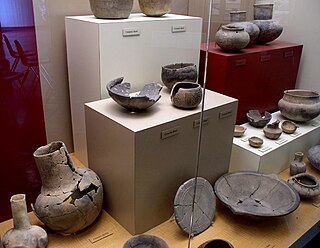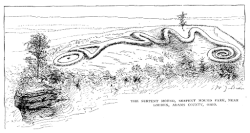
The archaeology of the Americas is the study of the archaeology of the Western Hemisphere, including North America (Mesoamerica), Central America, South America and the Caribbean. This includes the study of pre-historic/Pre-Columbian and historic indigenous American peoples, as well as historical archaeology of more recent eras, including the Trans-Atlantic slave trade and European colonization.

Processual archaeology is a form of archaeological theory. It had its beginnings in 1958 with the work of Gordon Willey and Philip Phillips, Method and Theory in American Archaeology, in which the pair stated that "American archaeology is anthropology, or it is nothing", a rephrasing of Frederic William Maitland's comment: "My own belief is that by and by, anthropology will have the choice between being history, and being nothing." The idea implied that the goals of archaeology were the goals of anthropology, which were to answer questions about humans and human culture. This was meant to be a critique of the former period in archaeology, the cultural-history phase in which archaeologists thought that information artifacts contained about past culture would be lost once the items became included in the archaeological record. Willey and Phillips believed all that could be done was to catalogue, describe, and create timelines based on the artifacts.

In the classification of the archaeological cultures of North America, the Archaic period in North America, taken to last from around 8000 to 1000 BC in the sequence of North American pre-Columbian cultural stages, is a period defined by the archaic stage of cultural development. The Archaic stage is characterized by subsistence economies supported through the exploitation of nuts, seeds, and shellfish. As its ending is defined by the adoption of sedentary farming, this date can vary significantly across the Americas.

Oneota is a designation archaeologists use to refer to a cultural complex that existed in the Eastern Plains and Great Lakes area of what is now occupied by the United States from around AD 900 to around 1650 or 1700. Based on the classification defined in Gordon Willey and Philip Phillips' 1958 book Method and Theory in American Archaeology, the Oneota culture belongs to formative stage. The culture is believed to have transitioned into various Siouan cultures of the protohistoric and historic times, such as the Ioway. A long-accepted ancestry to the Ho-chunk has yet to be conclusively demonstrated.

In the sequence of cultural stages first proposed for the archaeology of the Americas by Gordon Willey and Philip Phillips in 1958, the Lithic stage was the earliest period of human occupation in the Americas, as post-glacial hunter gatherers spread through the Americas. The stage derived its name from the first appearance of Lithic flaked stone tools. The term Paleo-Indian is an alternative, generally indicating much the same period.
In archaeology, the general meaning of horizon is a distinctive type of sediment, artefact, style, or other cultural trait that is found across a large geographical area from a limited time period. The term derives from similar ones in geology, horizon or marker horizon, but where these have natural causes, archaeological horizons are caused by humans. Most typically, there is a change in the type of pottery found and in the style of less frequent major artefacts. Across a horizon, the same type of artefact or style is found very widely over a large area, and it can be assumed that these traces are approximately contemporary.
Gordon Randolph Willey was an American archaeologist who was described by colleagues as the "dean" of New World archaeology. Willey performed fieldwork at excavations in South America, Central America and the Southeastern United States; and pioneered the development and methodology for settlement patterns theories. He worked as an anthropologist for the Smithsonian Institution and as a professor at Harvard University.

The Chiripa culture existed between the Initial Period/Early Horizon, from 1400 to 850 BCE along the southern shore of Lake Titicaca in Bolivia.
Several periodisations are employed for the periodisation of the Indus Valley Civilisation. While the Indus Valley Civilisation was divided into Early, Mature, and Late Harappan by archaeologists like Mortimer Wheeler, newer periodisations include the Neolithic early farming settlements, and use a stage–phase model, often combining terminology from various systems.

In archaeological cultures of North America, the classic stage is the theoretical North and Meso-American societies that existed between AD 500 and 1200. This stage is the fourth of five stages posited by Gordon Willey and Philip Phillips' 1958 book Method and Theory in American Archaeology.

In the classification of the archaeology of the Americas, the Post-Classic stage is a term applied to some pre-Columbian cultures, typically ending with local contact with Europeans. This stage is the fifth of five archaeological stages posited by Gordon Willey and Philip Phillips' 1958 book Method and Theory in American Archaeology.
- The Lithic stage
- The Archaic stage
- The Formative stage
- The Classic stage
- The Post-Classic stage
The Belle Glade culture, or Okeechobee culture, is an archaeological culture that existed from as early as 1000 BCE until about 1700 CE in the area surrounding Lake Okeechobee and in the Kissimmee River valley in the Florida Peninsula.

This is a timeline of in North American prehistory, from 1000 BC until European contact.

The Laurel complex or Laurel tradition is an archaeological culture which was present in what is now southern Quebec, southern and northwestern Ontario and east-central Manitoba in Canada, and northern Michigan, northwestern Wisconsin, and northern Minnesota in the United States. They were the first pottery using people of Ontario north of the Trent–Severn Waterway. The complex is named after the former unincorporated community of Laurel, Minnesota. It was first defined by Lloyd Wilford in 1941.
Prehistoric technology is technology that predates recorded history. History is the study of the past using written records. Anything prior to the first written accounts of history is prehistoric, including earlier technologies. About 2.5 million years before writing was developed, technology began with the earliest hominids who used stone tools, which they first used to hunt food, and later to cook.
Robert M. Rosenswig is a Mesoamerican archaeologist born Oct. 30, 1968 in Montreal, Canada. He earned a B.A at McGill University in 1994, an M.A. at the University of British Columbia in 1998 and Ph.D. in 2005 from Yale University. Rosenswig currently conducts research projects Mexico, Belize, and Costa Rica. His research explores the emergence of sociopolitical complexity and the development of agriculture.

Several chronologies in the archaeology of the Americas include an Archaic Period or Archaic stage etc. It is often sub-divided, for example into "Early", "Middle" and "Late", or alternatively "Lower" and "Upper", stages. The dates, and the characteristics of the period called "Archaic" vary between different parts of the Americas. Sometimes also referred to as the "Pre-Ceramic stage" or period, it followed the Lithic stage and was superseded by the Formative stage, or a Preformative stage. The typical broad use of the terms is as follows:









